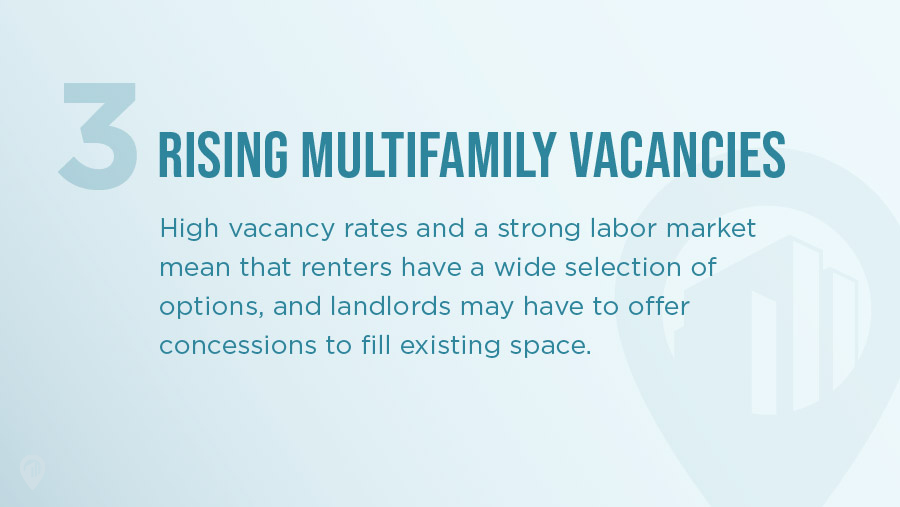Multifamily Rent Growth Sinks Below Pre-Pandemic Averages

Specializes in providing actionable insights into the commercial real estate space for investors, brokers, lessors, and lessees. He covers quarterly market data reports, investment strategies, how-to guides, and top-down perspectives on market movements.

After record gains in 2022, the multifamily real estate market is showing signs of moderating. Factors ranging from rising interest rates and rising inflation to supply chain issues and falling consumer confidence are putting pressure on multifamily real estate markets in most major cities.
According to data from Apartment List, year-over-year (YoY) rental growth in 2022 was at 2.6%, nearly 20 basis points lower than rental growth averages from 2018 to 2019. Moreover, experts predict that rental growth will remain subdued in the face of ample construction and increased vacancies.
Why Are Multifamily Rental Growth Rates Falling?
Landlords and tenants are reorienting themselves in this current high interest rate market, effectively slowing down rent growth. This period of price discovery is affected by higher interest rates increasing cap rates and putting downward pressure on real estate valuations.
#1 – Falling Consumer Confidence

Slowing rental growth rates could also partially be due to falling consumer confidence. Consumer confidence was at a record low in mid-2020 at lower than 90 and had barely clawed its way to over 100 by the end of 2022.
Low confidence is a function of economic uncertainty and many experts' predictions of an ensuing recession in 2023. Under low certainty, household formation is lower, and people are less likely to move.
#2 – Seasonal Shifts in Multifamily Rents
Rental growth rates typically slow in the fall and the winter and rise again in the first half of the following years.
Although rents did follow that pattern from 2022 to 2023, rental drops in winter were much more significant than they usually are. Winter rental drops were higher than the previous five years, and start-of-year rental growths have been lower than pre-pandemic.
#3 – Rising Multifamily Vacancies

As many have pointed out, one of the major factors driving the massive rental growth spike across 2020 and 2021 was tight supply and low vacancy rates. Vacancy rates in 2021 were low at around 4% but have risen to over 6% by the end of 2022—a 1.2% YoY increase from 2021. Vacancy rates are now at approximately pre-pandemic levels.
This means that we are in a tenant's market for the first time in a long time. High vacancy rates and a strong labor market mean that renters have a wide selection of options, and landlords may have to offer concessions to fill existing space.
Additionally, many cities are investing in a substantial amount of multifamily units to be delivered in 2023, 2024, and beyond. As of the beginning of 2023, there are over one million apartments under construction in the US, which is the largest amount under construction since 1970. Specifically, construction rates for multifamily homes with two to four units have skyrocketed since 2020.
The Sun Belt Dominates in YoY Rental Growth
Although national average rental growth rates slowed, several urban pockets showed exceptional rental growth. According to recent data, the cities with the highest rental growths from 2019 to 2023 in the US were Tampa-St. Petersburg, Fort Lauderdale, Jacksonville, and Tuscon at 57%, 54.4%, 52.9%, and 49.8%, respectively.
A significant portion of high rental growth is concentrated in Sun Belt states, such as Florida, Texas, Arizona, and North Carolina. These areas are seeing exceptional growth thanks to a combination of high migration, low costs, and favorable weather.
Moreover, a strong labor market indicates high tenant demand as job markets in these areas continue to grow.
Coastal Cities Fell Behind in Rental Growth
Much of the lowest growth was concentrated in older gateway markets, including East and West Coast metropolitan areas. The cities with the lowest rental growth between 2019 and 2023 were San Francisco, NYC, San Jose, and Oakland at 2.0%, 8.5%, 12.0%, and 15.5%, respectively. Markets with lower rental growth were characterized by lengthier development and lower job growth.
Additionally, these larger and older markets were affected more by the pandemic and have taken longer to recover than other cities in the South. The more moderate pace of rental growth (and negative rental growth in some cases) has eased the costs of living in these large cities.
Difficulties in Buying Single-Family Homes With Reorienting Market Demand in the Long Term
Although multifamily vacancies and construction will slow rental growth in the near term, various structural features will reorient demand toward multifamily housing in the long term.
Specifically, rising mortgage rates and rising costs of single-family home construction have made millennials less likely to purchase a home. This demand for housing will be reoriented toward multifamily accommodations.
For example, high inflation and the larger commitment in buying a home may incentivize people to favor the standard one-year apartment lease as it is more predictable and easier to budget. The larger single-family housing crisis is expected to increase the value proposition of apartments as people rent longer into their lives.
Our 2023 Rental Growth Outlook
Despite average multifamily rental rates falling below pre-pandemic averages, multifamily investors are not in a state to panic. Compared to other types of commercial real estate, such as office space or industrial/warehouse space, multifamily properties are a leading investment choice.
Rising single-family homes have priced many people out of their previous neighborhoods, and demand for multifamily accommodations will consequently rise. Like most other sectors, multifamily construction will likely encounter delays, but momentum will pick up as we move into the second half of 2023.
In the meantime, multifamily investors can best take advantage of the slowing market by acquiring high-quality Class A buildings. Most rental growth in hot markets is from new Class A and higher constructions, making them an extremely lucrative option for multifamily investors.
Find & Connect With Commercial Real Estate Agents & Brokers for Free on MyEListing.com
MyEListing.com maintains one of the largest commercial agent directories in the country. Use it for free to find an agent or broker near you.
Article Search
Share
All Article Categories








